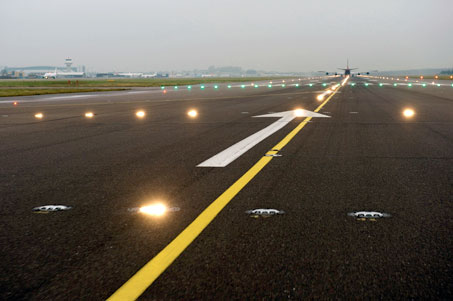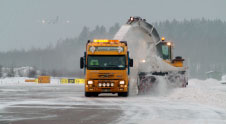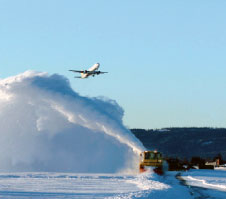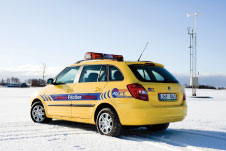
Fraser-Bennison: “CFME is essentially a maintenance tool to measure trends in the change of grip displayed by a runway surface. If regular testing shows that the levels of grip are safe, then provided the runway is free of contaminants, an assured level of wet braking performance can be used by operators using aircraft manufacturers' performance figures.”
The reliability of runway friction testers in extreme weather conditions is perhaps something that cannot be definitely assessed, purely given the constantly changing nature of these conditions, particularly during the winter season. Indeed, the ultimate solution of relating the output from friction measurement devices to aircraft performance is still being sought. “The direct relationship has not been established, and most probably will not be found. Mainly because there is no fixed reference to which the measurements can be related,” commented Norheim. “Due to the lack of reference, one cannot use the term accuracy, but must use the term uncertainty. There are several elements in this uncertainty, one being the repeatability of the measurements. That is the ability of a measuring device to repeat the same measurements under similar conditions. The other is reproducibility; the ability of another measuring device of the same make and kind to reproduce a measurement under similar conditions.”
Reliability of readings

The reliability of runway friction testers in extreme weather conditions is perhaps something that cannot be definitely assessed, purely given the constantly changing nature of these conditions, particularly during the winter season.
In terms of reliability of the readings, it depends on the type of extreme weather. Fraser-Bennison explained that many countries in northern latitudes can see stable winter conditions that persist for weeks and in some cases months. Where such conditions occur, compacted snow and ice can be assessed using Continuous Friction Measuring Equipment (CFME) and reliable readings passed to aircraft operators. Those operators have Snow & Ice tables to which they can refer in order to recalculate take-off and landing performance.  “In other conditions, whether extreme or not, the variability of the contaminants typically encountered in wintery weather renders readings unreliable. This is because there are established technical criteria which bound the operation of all CFME. These include a dry runway and temperature above 2 degrees Celsius, so although a reading will be generated, it cannot be relied upon as the conditions were non-compliant,” commented Fraser-Bennison.
“In other conditions, whether extreme or not, the variability of the contaminants typically encountered in wintery weather renders readings unreliable. This is because there are established technical criteria which bound the operation of all CFME. These include a dry runway and temperature above 2 degrees Celsius, so although a reading will be generated, it cannot be relied upon as the conditions were non-compliant,” commented Fraser-Bennison.
He continued: “CFME is essentially a maintenance tool to measure trends in the change of grip displayed by a runway surface. If regular testing shows that the levels of grip are safe, then provided the runway is free of contaminants, an assured level of wet braking performance can be used by operators using aircraft manufacturers performance figures. No matter how extreme or otherwise the weather is, there are only a very limited set of circumstances that permit the tactical deployment of CFME.”
Training of personnel

Norheim: “Due to the lack of reference, one cannot use the term accuracy, but must use the term uncertainty. There are several elements in this uncertainty, one being the repeatability of the measurements.”
As regards further improving friction testing in adverse conditions, Norheim contended that the answer lies in the training of the personnel who perform the assessment of runway conditions during adverse weather. “The personnel should be trained and competent and know the possibilities and the limitations of the friction measuring devices, and use their best judgment when using measured data as part of their assessment when allowed,” he said. “The further development of the actual friction measuring devices might give some extra quality, but it is not expected that a major breakthrough approved by the aircraft manufacturers will be the result. It is more likely that future development will be making use of the aircraft itself as a friction measuring device. The technology exists; aircraft can detect friction limited surface conditions. That is, surface conditions where the full potential of the brakes cannot be utilised. This information can be made available to the ground personnel, and maintenance activities be initiated to prevent the friction limited surface conditions developing further by reducing/eliminating their causes. There are projects using such technology already, and it might be more readily available in a not so distant future.”
Extreme weather, of course, constitutes a broad category of constantly changing conditions. Variable friction measurements seem inevitable; not resulting from technical limitations of friction measurement devices, but simply because of the ever-changing conditions during extreme weather.
Automatic freezing point detection
 Landing aircraft rely on the strip being properly prepared and ready for intense action when heavy wheels hit the tarmac. The wheels are responsible for safely carrying the dynamic load and for bringing the airliner to a safe halt. A demanding task, especially when weather conditions are frosty.
Landing aircraft rely on the strip being properly prepared and ready for intense action when heavy wheels hit the tarmac. The wheels are responsible for safely carrying the dynamic load and for bringing the airliner to a safe halt. A demanding task, especially when weather conditions are frosty.
Frensor is a patented solution for an exact detection of the freezing point temperature. The Frensor is by far more accurate and reliable than traditional ‘Bridge Freeze First’ warnings or thermometers.
The Frensor can be installed in the runway as fixed units or as mobile units on vehicles, collecting surface freezing temperatures in real time. Frensors can also be connected to any host computer system via a serial port.
The Frensor uses a Peltier element to heat and cool the fluid on the sensor head to determine the exact freezing point, and is independent of the de-icing fluid used. Cost savings up to 30% are within reach. Less de-icing fluid is also beneficial for the environment. The correct freezing point is detected, without special calibration, even if the fluid is contaminated with unknown chemicals. Typical applications are runways and bridge sprayer systems where correct and precise information is essential. The Frensor can also be used in mobile applications, built into an ASFT car for continuous friction measuring or in a handheld attaché case for investigations at various spots.
ASFT develops continuous friction measuring technology, complete with weather monitoring systems devoted to frost and precipitation.







